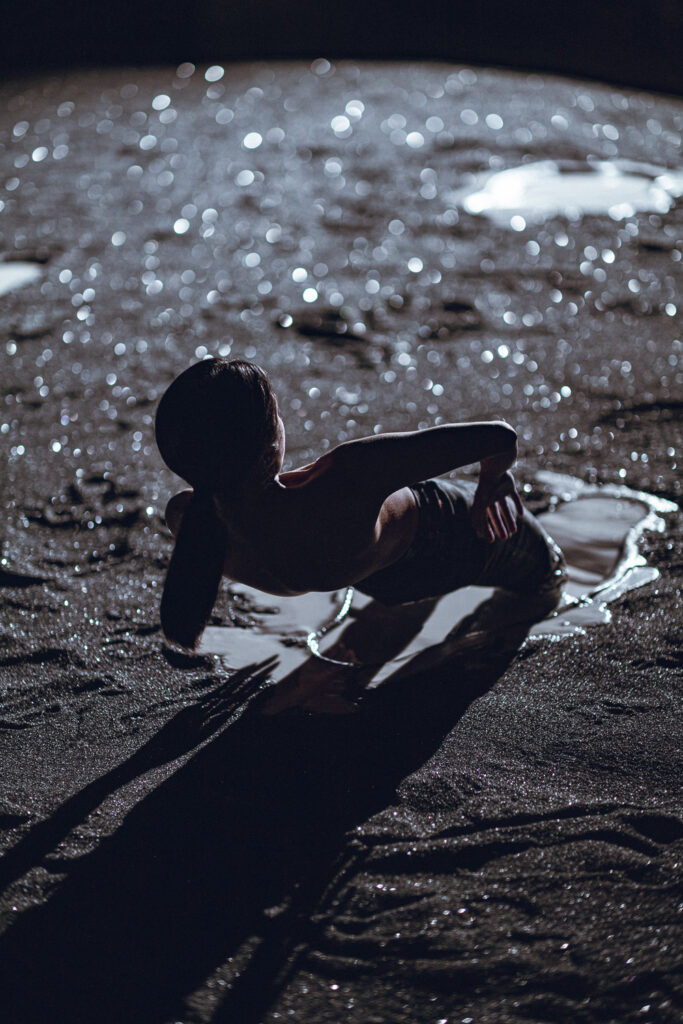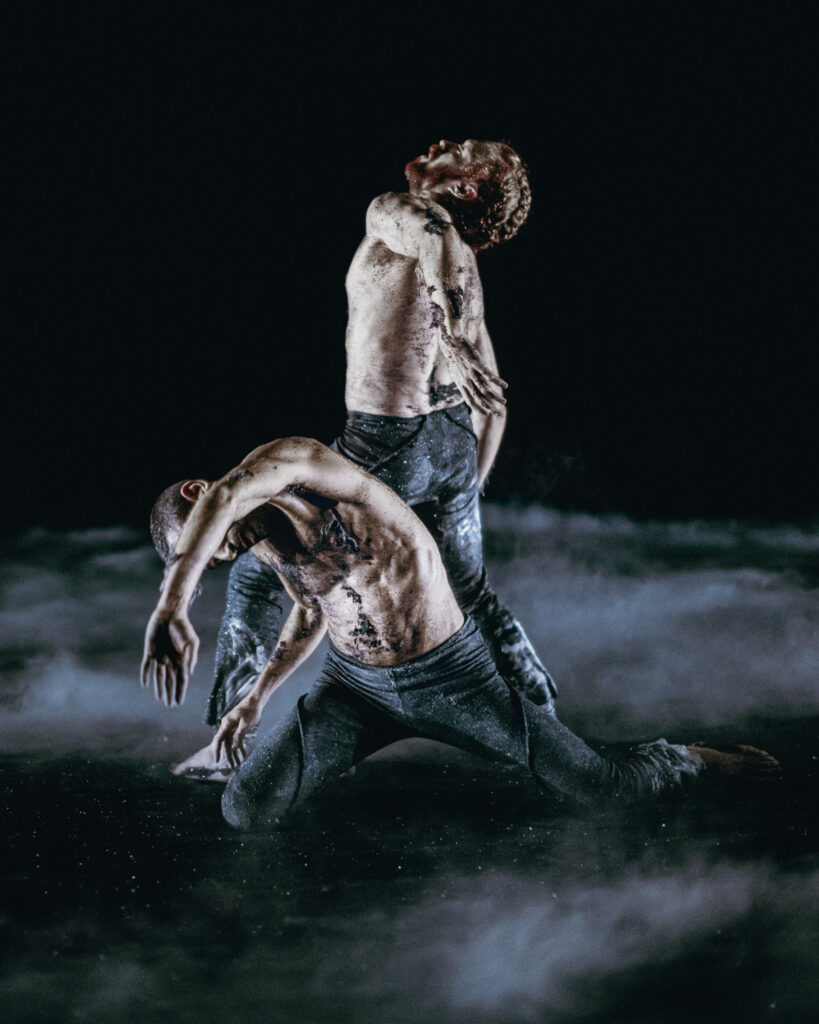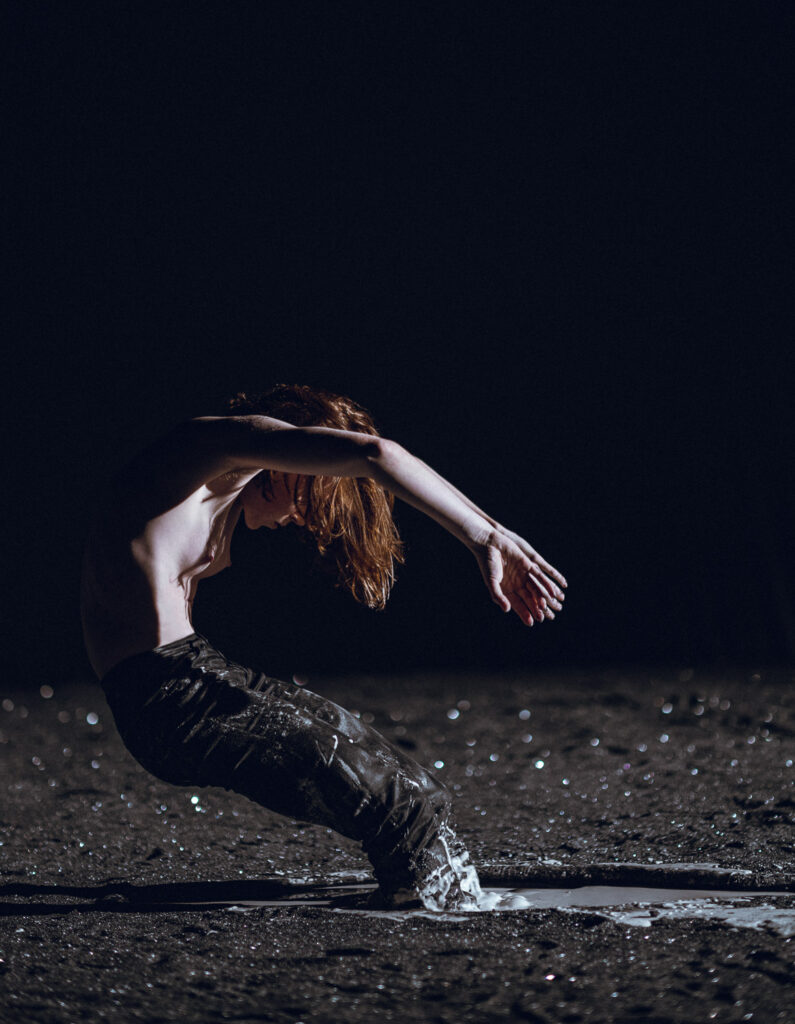Planet [wanderer]
Between choreography and visual experimentation, Planet [wanderer] exposes the body of the dancers in different materials to evoke in a visceral and oneiric way, the bound between human beings and their planet.

The encounter between the visual artist Kohei Nawa and the choreographer Damien Jalet was artistic love at first sight. What brought them together is most certainly this alchemy of matter that can be found in the moving sculptures as well as in the gestures of one another. Their first joint opus, Vessel, recalled two levels of the creation of the world according to Japanese mythology: the abyss and the world above the clouds. Planet [wanderer], the second part of this diptych, takes place in the “middle earth of reeds”, in other words, in our world. Here, a scintillating black sand, stardust or meteorite, shaped a landscape, that the presence of the bodies then surreptitiously modifies. Through the confrontation of the human body with various experimental materials, elements and gravity, Planet [wanderer] is a physical and poetic evocation of the migratory nature of life and of the powerful and fragile relationship that connects us to this spheric nomad that is our planet.
PLANAOMAI
The word planet has the same root as the Greek term meaning the wanderer. This common etymology once helped differentiate stars from moving celestial bodies. The first image Damien showed me was a stump spewed out by the surf in Ishinomaki, one of the cities hardest hit by the 2011 tsunami where he had just started production on Planet [wanderer] with Kohei Nawa. On the photograph you could see huddled bodies clutching the root splayed across the shore.
Vessel, the previous collaboration between the choreographer and the visual artist, was the last show I was able to see before theaters shut down. The piece was divided between the underground world and the celestial plain described in the Kojiki, one of the early cosmogonies in Japan. This atmospheric experience probed the confines of their respective mediums which eventually merged and transcended themselves into a cell-shaped autonomous ecosystem. The performers’ faces always remained invisible.
The second installment of this diptych now focuses on the transitional space of the ashihara-no-nakatsukuni, literally “the heartland of reeds”, a depiction of the world we live in with its own choreography, constantly shifting, always drifting, like the beings that dwell in it. By zooming in on the pale blue dot, Planet [wanderer] scrutinizes the transfigurations of that object whose living memory mutates at every moment, be it a wave in the ocean, rock scree on the ground or a fire in a forest.
When I came to attend the rehearsals at Chaillot, masked people were levelling a terraformed landscape that brought to mind mythology as much as science. As the lighting swept through the details of that metaphorical and metamorphic vantage point where everything seemed to interact, it felt like I was looking by turns at the debris of a meteorite or the ruins of another planet, a Zen garden, an alchemical lab or, more simply, terra firma, vulnerable, glistening, visceral and living.
The music composed by Tim Hecker combines electronic melodies and gagaku instruments in alternating synthetic and imperial washes, both conscious and unconscious. In the middle of the show excerpts from the Golden Record recordings sputter out a few human echoes. That record, which was sent into cosmic infinity in 1977 on the Voyager probe, aimed to give hypothetical aliens earth sounds such as thunder, farming noise or the song of a child, much like a message in a bottle.
Eight bodies, eight planets, eight paragraphs. The dancers are standing in front of me as if poised for a ritual. The movement of one influences the movement of the other so that those presences soon blend into one like Pangaea. Their silhouettes are anchored in a transitional space between the distant past and an uncertain future. Week after week I saw them become liquid, mineral or powdery, tectonic faults, microscopic creatures, statues, plants and ghosts, fossils, rain shower and then reeds, covered with sand, smoke and wax, wavering, nomadic, and always drifting.
Shifting through different states, defying gravity or combating unstable materials, the dancers skulk around on stage, work out strategies and veer off-kilter as they meet this ever-evolving terrain. Even though the set is dry, parched, and nostalgic for an extinct body of water like on Mars or in the desert, flowers still seem to be able to grow there. Beings are born and die. Others remember a moment that no longer exists. Zenithal light illuminates these vestiges of the future before it starts to rain.
One comes away as if from a tale or a daydream. A message informs me that climate change has changed the rotation axis of Earth. A sliver of light breaks through the clouds and disappears from the sky. As their migrations unfold, the bodies affect the landscape harmoniously and violently, impressing the floor with their footprints. We are walking on a celestial body moving through the universe at unimaginable speed. This world is moving, changing. The word wandering has the same root at the Greek term meaning planet.
Théo Casciani

PRESS
With the visual artist Kohei Nawa, Damien Jalet (associate artist of Chaillot) delivers an extraordinary epic on the evolution of humanity. Although seized with fear, we are overwhelmed by so much beauty, a poetic cosmogony at the crossroads of the arts. Unforgettable sensations and experience. –
Léna Martinelli Les trois coups
Under the influence of different Japanese rituals and at the crossroads of arts and cultures, the atmospheric dance of Damien Jalet is still well and truly porous of the forces of life and destruction that animate the universe. It finds a superb setting, as concrete as it is abstract, in the scenography of artist Kohei Nawa.”
Sceneweb
A breathtaking performance of grace, ingenuity and beauty.
L’œil d’Olivier
After the sumptuous Vessel which has been touring the world since, already, 2015, the duo formed by the choreographer Damien Jalet and the plastic artist Kohei Nawa returns to Chaillot with a no less dazzling creation, Planet [wanderer], which plunges the audience in a state of fascination on the edge of trance.
IO gazette
Choreography and visual art in perfect fusion. A striking performance.
Le figaro
CREDITS
CHOREOGRAPHY Damien Jalet
SCENOGRAPHY Kohei Nawa
MUSIC Tim Hecker
LIGHTS Yukiko Yoshimoto
SOUND CREATION COLLABORATOR Xavier Jacquot
CHOREOGRAPHY ASSISTANT Alexandra Hoàng Gilbert
OUTSIDE EYE Catalina Navarrete Hernández
WITH Shawn Ahern, Kim Amankwaa, Aimilios Arapoglou, Francesco Ferrari, Vinson Fraley, Christina Guieb, Astrid Sweeney, Ema Yuasa
PRODUCTION Chaillot – Théâtre national de la Danse
COPRODUCTION Sandwich Inc., Théâtre National de Bretagne, Festspielhaus St. Pölten, Tokyo Metropolitan Theatre, Rohm Theatre Kyoto, Opéra de Rouen Normandie
WITH THE SUPPORT OF Grand Marble, MATSUSHIMA HOLDINGS CO., LTD
ACKNOWLEDGMENTS Théo Casciani
View More
See more projects Films Other Projects Performances















